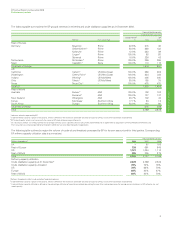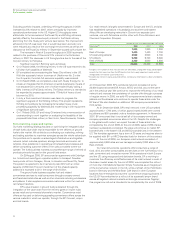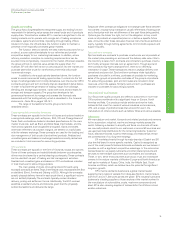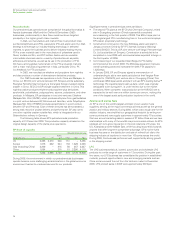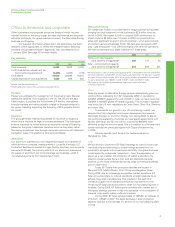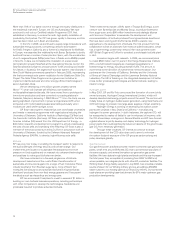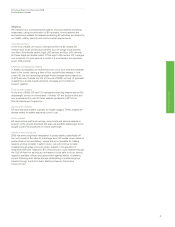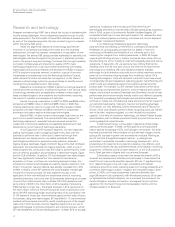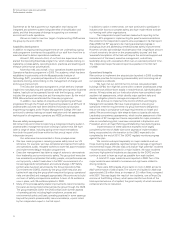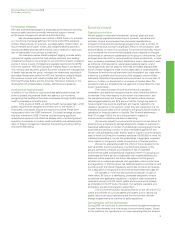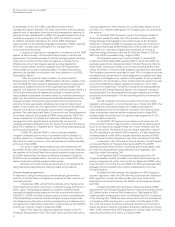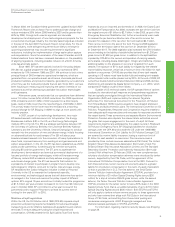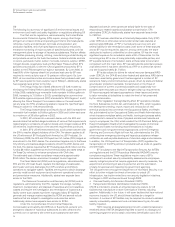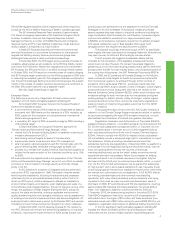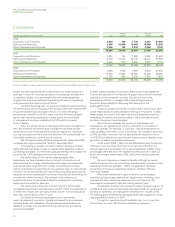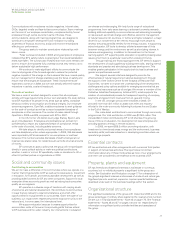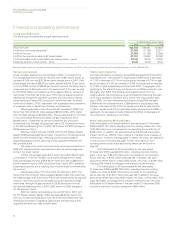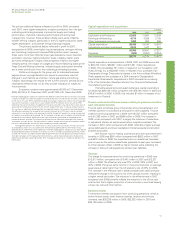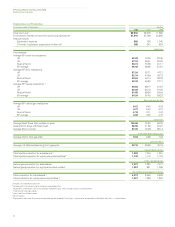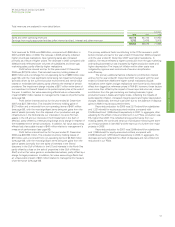BP 2008 Annual Report Download - page 44
Download and view the complete annual report
Please find page 44 of the 2008 BP annual report below. You can navigate through the pages in the report by either clicking on the pages listed below, or by using the keyword search tool below to find specific information within the annual report.
BP Annual Report and Accounts 2008
Performance review
Performance indicators
We have well-developed systems, processes and metrics for reporting
personal safety and environmental metrics that support internal
performance management as well as public reporting.
We introduced several new metrics in 2008 that aim to enhance
our monitoring of process safety performance within BP’s operating
entities. These include, for example, a process safety incident index, as
recommended by the panel, which uses weighted severity scores to
record and assess process safety events, and a measure to record any
loss of hydrocarbon from primary containment.
Our indicators include industry-aligned ‘lagging’ process safety
metrics that register events that have already occurred, and ‘leading’
indicators that focus on the strength of our controls to prevent undesired
events in future. A suite of indicators is regularly reported to the GORC
within the quarterly ‘HSE and Operations Integrity Report’ and several
new metrics have also been piloted. To further enhance the management
of health risks across the group, we began the systematic reporting of
recordable illness rates within the HSE and Operations Integrity Report.
We continue to work with industry bodies such as the Centre for
Chemical Process Safety and the American Petroleum Institute on the
development of process safety metrics, definitions and guidance.
Continuing to focus on health
In addition to our efforts to improve process safety performance, we
strive to protect the personal health and safety of our workforce,
recognizing that healthy performance is delivered through healthy people,
healthy processes and healthy plant.
In the course of 2008, we defined health ‘group essentials’, which
specify requirements designed to prevent harm to the health of
employees, contractors, visitors and local communities. These were
incorporated within the OMS framework. Our health strategy and plan
was also refreshed in 2008. Priorities include reducing significant
occupational exposure and infectious disease risks, maintaining robust
regulatory compliance in product health and safety and addressing the
issue of fatigue management raised by the panel by providing training
and awareness-raising.
Environment
Regulation and claims
We are subject to extensive international, national, state and local
environmental regulations concerning our products, operations and
activities. Current and proposed fuel and product specifications,
emission controls and climate change programmes under a number of
environmental laws will have a significant effect on the production, sale
and profitability of many of our products. Environmental laws also require
us to remediate the environmental impacts of prior disposal or releases
of chemicals or petroleum substances by the group or other parties. Such
contingencies may exist for various locations where products are, or have
been, produced, processed, stored, distributed, sold or disposed of, such
as refineries, chemical plants, natural gas processing plants, oil and
natural gas fields, service stations, terminals and waste disposal sites.
Some of these obligations relate to prior asset sales or closed facilities.
Provisions for environmental restoration and remediation are made when
a clean-up is probable and the amount of the obligation can be reliably
estimated. Generally this coincides with commitment to a formal plan of
action or, if earlier, on divestment or on closure of inactive sites. The
provisions made are considered by management to be sufficient to meet
known requirements.
The extent and cost of future environmental restoration,
remediation and abatement programmes are often inherently difficult
to estimate. They often depend on the extent of contamination, and
the associated impact and timing of the corrective actions required,
technological feasibility and BP’s share of liability. Though the costs of
future programmes could be significant and may be material to the
results of operations in the period in which they are recognized, it is not
expected that such costs will be material to the group’s overall results of
operations or financial position or liquidity. See Financial statements –
Note 37 on page 158 for the amounts provided in respect of
environmental remediation and decommissioning.
We are also subject to environmental and common law claims for
personal injury and property damage alleging the release or exposure to
hazardous substances. A number of proceedings involving governmental
authorities are pending or known to be contemplated against BP and
certain of its subsidiaries under federal, state or local environmental laws,
each of which could result in monetary sanctions of $100,000 or more. No
individual proceeding is, nor are the proceedings in aggregate, expected
to be material to the group’s results of operations or financial position.
We cannot accurately predict the effect of future developments,
such as stricter environmental laws or enforcement policies on the
group’s operations, products or profitability. A risk of increased
environmental costs and operational impacts is inherent in grouping our
businesses and there can be no assurance that material liabilities and
costs will not be incurred in the future. We believe that the group’s
activities are in material compliance with applicable environmental laws
and regulations, or that the group has disclosed such non-compliance and
is working with the relevant regulatory authorities to ensure compliance.
For a discussion of the group’s environmental expenditure see page 57.
BP operates in more than 90 countries worldwide. In each of
these areas, BP has, or is developing, processes designed to ensure
compliance with applicable regulations. In addition, each employee is
required to comply with BP health, safety and environmental policies
as embedded in the BP code of conduct. Our partners, suppliers and
contractors are also encouraged to adopt them.
This Environment section focuses primarily on the US and the EU,
where around 61% of our fixed assets are located, and on issues of a
global nature such as our operations and the environment, climate
change programmes and maritime oil spills regulations.
Our operations and the environment
During 2008, we continued to use environmental management systems
to seek improvements on a wide range of environmental issues. Except
at two locations, the operations at our major operating sites are covered
Performance review
43


